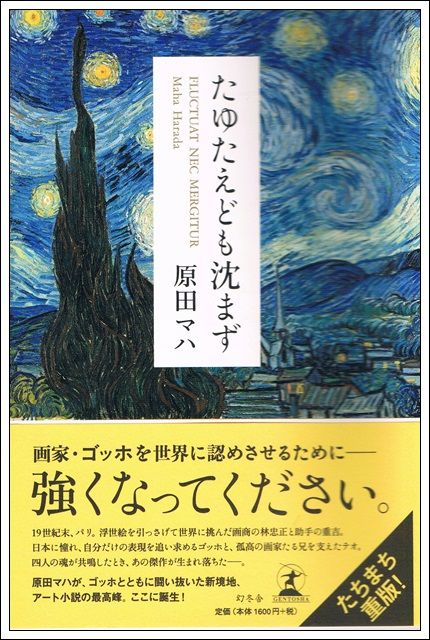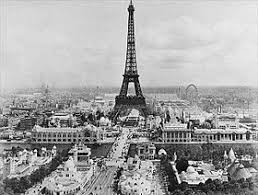Hayashi Tadamasa's Legacy is what we should all strive for
Abstract: In this post, I will examine the ways in which Hayashi Tadamasa's aims at the Paris World Affair in 1900 were perceived at the time, and today. It will argue that while Hayashi is perceived to have sold off ukiyo-e paintings abroad, this is challengeable in that he aimed foreign audiences to accept Japanese art as a whole, not just ukiyo-e paintings.
Hayashi Tadamasa (林忠正) briefly became a trendy historical figure in Japan when Harada Maha (原田マハ)published “たゆたえども沈まず(Swaying yet never sinking)” last year and won fourth place at Japan’s Bookstores’ Award. This art history fiction revolves around the relationship between the most renowned artist, Vincent van Gogh, and a talented art dealer Hayashi Tadamasa.




With that being said, I will start reflecting upon Hayashi’s actions at the World Fair. In order not to repeat the same failure, Hayashi made several changes in the way Japanese art was presented. When in Paris, do as the Parisians do. This included presenting the craft objects and fine art separately, appointing amateur journalists to inspect artworks, and selectively presenting the artworks instead of unlimitedly doing so like in the previous World Fairs. Hayashi also ignored the protocol that basically said “Japanese ambassador to France will become vice president when the president or vice president is not in France” and proceeded to apply all his authority at the World Fair. This was unprecedented, and had invited disapprovals.
Hayashi Tadamasa (林忠正) briefly became a trendy historical figure in Japan when Harada Maha (原田マハ)published “たゆたえども沈まず(Swaying yet never sinking)” last year and won fourth place at Japan’s Bookstores’ Award. This art history fiction revolves around the relationship between the most renowned artist, Vincent van Gogh, and a talented art dealer Hayashi Tadamasa.
This Hayashi Tadamasa guy is an interesting figure. Despite the fact that Hayashi played a huge role in impacting European impressionist artists and introducing impressionism to Japan through his amazing merchandise skills ever since he started a new life in Paris in 1878, his existence remained quite obscure until recent years. Even for those who knew Hayashi, the reputations had been harshly negative to the extent that he was widely known as the infamous “春画の盗賊 (thief of shunga).”
Contrary to the generally unfavorable domestic opinions, the French government recognized Hayashi’s achievements and awarded him the most prestigious Legion d’honneur award on 1900. This was greatly attributed to his achievements as a general commissioner of the Japanese Art Section in the Paris World’s Fair in 1900. However, the Paris World’s Fair was like a double-edged sword for Hayashi. It also provoked domestic animosity and social stigma against him.
There’s no need of rocket science to figure out that Hayashi made a huge action and did something that profoundly pleased the French but awfully angered the Japanese in the Paris World’s Fair in 1900. So, this will be the topic for today’s post. What did Hayashi do?
Before taking a stab at that, I would want to talk about how and why Hayashi became a general commissioner. This position was usually taken by someone in the Ministry of Agriculture and Commerce, and wasn’t for a “shameful” merchant like Hayashi.
By the end of the 19th century, Hayashi allegedly planned to leave Paris due to the downfall of the Japonism trend in Europe, the failures at the World’s Fair in Chicago and Lyon on 1893 and 1894 respectively, and the loss of visions on ukiyo-e. More specifically, the failures primarily referred to the terrible way Japanese art was presented, and heavy losses in the business due to the blunder of his office. In other words, Hayashi wanted to leave Paris to heal his wounds from these failures, and was extremely anxious and worried that Japan would once again fail at the World’s Fair in Paris.
But before leaving Paris, Hayashi sent a memorandum to Sone Arasuke (曾禰荒助) who was a Japanese ambassador to France. The memorandum mainly conveyed his righteous indignation about the failures at the aforementioned World’s Fairs. Fortunately or unfortunately, this convinced the Japanese ambassadors that Hayashi would be a perfect fit for a general commissioner at the World Fair, due to his rich knowledge about the situations in Paris combined with past experiences at the World Fairs.
With that being said, I will start reflecting upon Hayashi’s actions at the World Fair. In order not to repeat the same failure, Hayashi made several changes in the way Japanese art was presented. When in Paris, do as the Parisians do. This included presenting the craft objects and fine art separately, appointing amateur journalists to inspect artworks, and selectively presenting the artworks instead of unlimitedly doing so like in the previous World Fairs. Hayashi also ignored the protocol that basically said “Japanese ambassador to France will become vice president when the president or vice president is not in France” and proceeded to apply all his authority at the World Fair. This was unprecedented, and had invited disapprovals.
Japanese newspapers casted opprobrium upon Hayashi’s bold actions to do it the French way. There are tons of primary sources that lacerate Hayashi, so I will translate it from Japanese to English, and list some of them in bullet points.
- Tokyo Nichi Nichi Shinbun (東京日日新聞), 13 August 1899: “Hayashi is only concerned of his own benefits and self-interests” “By separating craft objects and fine arts, Hayashi is narrowing the perceptions of fine art like they do abroad”
- Kensei Shinbun (憲政新聞), 25 August 1899: “Hayashi is at fault for the sins. Hayashi is at guilt and deserves condemnation.”
- Tokyo Asahi Shinbun (東京朝日新聞), 10 November 1899: Sarchastically refers to Hayashi as a “gentleman in Paris who received lots of criticisms” and describes how Hayashi was greedy and impudent, asking for money.
However, for the sake of protecting Hayashi’s integrity, I will drop some historical facts that will refute these haphazard, groundless denunciations.
First of all, Hayashi never benefited financially from the World Fair. In fact, he suffered great losses instead. Hayashi became a general commissioner under the condition that he abandon all merchandise activities. Hayashi’s younger brother succeeded his business, however, it did not go well, and it was nearly out of business. Additionally, as mentioned before, Hayashi’s originally intended to leave Paris before the World Fair, however, because he had decided to contribute, his return to Japan delayed for five years, which financially damaged him as well.
In spite of these, Hayashi refused to receive any sort of income for becoming a general commissioner. In fact, he accomplished his job by paying all expenses out of his own pocket.
It is interesting that the infamous epithet, “thief of shunga” never appeared in any of the newspapers at that time. Japanese society still repeatedly rejected ukiyo-e as low culture, and never understood its intrinsic and artistic value. In the aftermath, when they finally realized its worth, they began to also blame Hayashi for leaking such precious art abroad.
As Hayashi Tadamasa himself said, he accepted the position as a general commissioner to preserve national pride and integrity and understood that he had heavy responsibilities attached to that.
References
Jouzuka, Taketoshi. “Umi wo Wataru Ukiyoe (Ukiyoe Crossing the Sea).” Bijutsu Kouronsha, 1981.
Kashima, Shigeru. “Pari no Nihonjin (Japanese people in Paris): Nihon Bijutsu no Daionjin, Hayashi Tadamasa (A Huge Benefactor to Japanese Art, Hayashi Tadamasa)” Shincho Sensho, 2009. pp.66-89
Kigi Yasuko “Hayashi Tadamasa to Sono Jidai” Chikuma Shobou, 1987.

Comments
Post a Comment